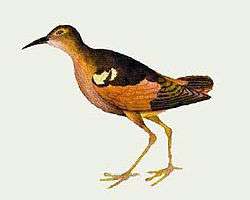Moorea sandpiper
| Moorea sandpiper | |
|---|---|
 | |
| Illustration by William Ellis | |
| Scientific classification | |
| Kingdom: | Animalia |
| Phylum: | Chordata |
| Class: | Aves |
| Order: | Charadriiformes |
| Family: | Scolopacidae |
| Genus: | Prosobonia |
| Species: | † P. ellisi |
| Binomial name | |
| Prosobonia ellisi Sharpe, 1906 | |
The Moorea sandpiper or white-winged sandpiper (Prosobonia ellisi) is an extinct member of the large wader family Scolopacidae that was endemic to the Moorea in French Polynesia, where the locals called it te-te in the Tahitian language.
Two specimens were collected by William Anderson between September 30 and October 11, 1777, during Captain Cook’s third voyage, but both have since disappeared and the bird became extinct in the nineteenth century. The only hint at its former existence are Anderson's notes and the descriptions based on them, a painting by William Ellis and a plate by J. Webber which apparently depicts the other specimen.
These show a somewhat lighter brown bird than the Tahiti specimen, with no white spot behind the eye, a more conspicuous light rusty eye-ring, two white wing-bars and rusty secondary and primary coverts; one of Latham's specimens had yellow legs and feet. The exact relationships between the Moorea bird and the Tahiti sandpiper are still not fully resolved.
References
- ↑ BirdLife International (2012). "Prosobonia ellisi". IUCN Red List of Threatened Species. Version 2013.2. International Union for Conservation of Nature. Retrieved 26 November 2013.
Further reading
- Greenway, James C. (1967): Tahitian Sandpiper. In: Extinct and Vanishing Birds of the World (2nd ed.): 263–264. Dover Publications, New York.
- Latham, John (1785): "White-winged Sandpiper": In: A general synopsis of birds 3: 172, plate 82. London.
- Latham, John (1824): "White-winged Sandpiper": In: A general history of birds 9: 296.
- Sharpe, Robert Bowdler (1906). "Description of Prosobonia ellisi". Bulletin of the British Ornithologists' Club. 16: 86.
- Stresemann, Erwin (1950). "Birds collected during Capt. James Cook's last expedition (1776–1780)" (PDF). Auk. 67 (1): 66–88. doi:10.2307/4080770.
- Walters, Michael (1991). "Prosobonia ellisi, an extinct species of sandpiper from Moorea, Society Islands". Bollettino di Museo Regionale di Scienze Naturali Torino. 9: 217–226.
External links
- BirdLife species factsheet. Retrieved 11-SEP-2006.
